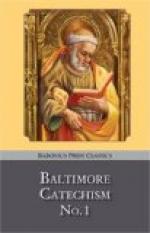After the Resurrection, at the last day, the bodies of all those who are to be in Heaven will have the qualities I have mentioned; that is, they will be glorified bodies.
Speaking of Our Lord’s wounds, I might tell you what the stigmata means, if you should ever hear or read of it. There have been some persons in the world—saints, of course—who have had upon their hands, feet, and side wounds just like those Our Lord had, and these wounds caused them great pain. For example, St. Francis of Assisi (see Butler’s Lives of the Saints, Oct. 4th). Up to 1883—that is, only a few years ago—there lived in Belgium a young girl named Louise Lateau who had the stigmata. We have the most positive proof of it, as you may see in the accounts of her life now published. Her wounds caused her great pain and bled every Friday for many years. She was a delicate seamstress, and lived with her mother and sisters in almost continual poverty. She had always been remarkable for her true piety, patience in suffering, and charity to the sick. I mention this young girl because she lived in our own time, and is the latest person we know of who had the stigmata, or wounds of Our Lord. So if you ever hear of the stigmata of St. Francis or others, you will know that it means wounds like those of Our Lord impressed on their bodies in a miraculous manner.
“Immortal”—that is never to die again, as it will be with us also after the Resurrection.
“The third day.” It was not three full days, but the parts of three days. Suppose someone should ask you on Friday evening how long from now to Sunday; you would answer: Sunday will be the third day from today. You would count thus: Friday one, Saturday two, and Sunday itself three. So it was with Our Lord. He died on Friday at about three in the afternoon, and remained in the sepulchre till Sunday morning.
90 Q. How long did Christ stay on earth after His resurrection? A. Christ stayed on earth forty days after His resurrection, to show that He was truly risen from the dead, and to instruct His Apostles.
After Our Lord’s resurrection He remained on earth forty days: but you must not think He was visible all that time. No. He did not appear to everybody, but only to certain persons, and not all the time to them either. He appeared to His Apostles and others in all about nine times; at least, we know for certain that He appeared nine times, though He may have appeared oftener. He showed that “He was truly risen,” for He ate with His Apostles and conversed with them. (Luke 24:42). It was after the resurrection that He breathed on them and gave them the power to forgive sins. (John 20).




